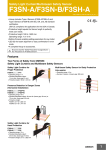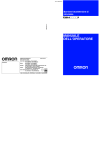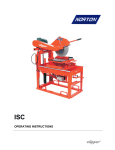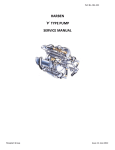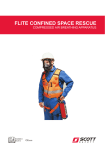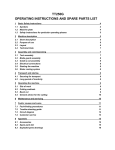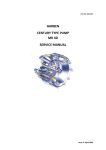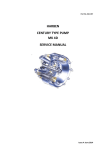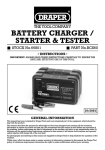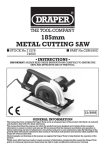Download Draper MS250 Owner`s manual
Transcript
254mm COMPOUND MITRE SAW ■ STOCK No. 52352 230V 55810 110V ■ PART No.MS250 • INSTRUCTIONS • IMPORTANT: PLEASE READ THESE INSTRUCTIONS CAREFULLY TO ENSURE THE SAFE AND EFFECTIVE USE OF THIS TOOL. 03/2001 GENERAL INFORMATION This manual has been compiled by Draper Tools and is an integrated part of the power tool equipment, which should be kept with the machine. This manual describes the purpose for which this tool has been designed and contains all the necessary information to ensure its correct and safe use.We recommend that this manual is read before any operation of the machine, before performing any kind of adjustment to the machine, and prior to any maintenance tasks. By following all the general safety instructions contained in this manual, it will ensure both machine and operator safety, together with longer life of the tool itself. All photographs and drawings in this manual are supplied by Draper Tools to help illustrate the operation of the machine. Whilst every effort has been made to ensure accuracy of information contained in this manual, the Draper Tool policy of continuous improvement determines the right to make modifications without prior warning. COMPOUND MITRE SAW ■ STOCK No.52352 230V 55810 110V CONTENTS: ■ PART No.MS250 Page No. Contents/Declaration .......................................................................................1 Specification/Guarantee...................................................................................2 Power Supply/Wiring Diagram ........................................................................3 General Safety Instructions for Power Tools .....................................................4 Additional Safety Instruction .........................................................................5-6 Getting To Know Your Mitre Saw .......................................................................7 Assembly ......................................................................................................8-9 Operation & Use ........................................................................................10-17 Glossary of Terms for Woodworking ..............................................................18 Maintenance...................................................................................................19 Troubleshooting .............................................................................................20 DECLARATION OF CONFORMITY We Draper Tools Ltd. Hursley Road, Chandler’s Ford, Eastleigh, Hampshire. SO53 1YF. England. Declare under our sole responsibility that the product: Stock Nos:- 52352 & 55810. Part Nos:- MS250. Description:- Compound Mitre Saws 230 Volt & 110 Volt. Testing Authority:- DET NORSKE VERITAS, File number 41210533 (230 Volt), TUV Rheinland, File number AM9956049 (110 Volt). To which this declaration relates is in conformity with the following directive(s) 89/392/EEC, 91/368/EEC, 93/44/EEC, 89/336/EEC, 92/31/EEC & 93/68,EEC. With reference to: EN292, prEN691, EN55014, EN55104, EN60555-2, & EN60555-3. JOHN DRAPER Managing Director 15/04/1997 -1- SPECIFICATION The Draper Tools policy of continuous improvement determines the right to change specification without notice. Part No. .................................................................. MS250 ..................................MS250 Stock No. ...................................................... 55810 (110V) ........................52352 (230V) Motor ......................................................................1800W ..................................1800W Blade diameter........................................................254mm ..................................254mm Blade bore ................................................................17mm ....................................17mm Speed ..................................................................4100rpm ................................4100rpm Cutting capacity: max. depth of cut 90° ............................70 x 142mm ..........................70 x 142mm mitre cut 45° ............................70 x 100mm ..........................70 x 100mm compound cut 45° ............................100 x 45mm ..........................100 x 45mm Weight nett/gross ..................................................20/22kg ................................20/22kg Sound power level ............................................112.6db(A) ............................112.6db(A) Sound pressure level ..........................................99.6db(A) ..............................94.0db(A) ALWAYS WEAR EAR AND EYE PROTECTION GUARANTEE Draper tools have been carefully tested and inspected before shipment and are guaranteed to be free from defective materials and workmanship for a period of 12 months from the date of purchase except where tools are hired out when the guarantee period is ninety days from the date of purchase. Should the machine develop any fault, please return the complete tool to your nearest authorized warranty repair agent or contact Draper Tools Limited, Chandler's Ford, Eastleigh, Hampshire, SO53 1YF. England. Telephone: (023) 8026 6355. If upon inspection it is found that the fault occurring is due to defective materials or workmanship, repairs will be carried out free of charge. This guarantee does not apply to normal wear and tear, nor does it cover any damage caused by misuse, careless or unsafe handling, alterations, accident, or repairs attempted or made by any personnel other than the authorised Draper warranty repair agent. This guarantee applies in lieu of any other guarantee expressed or implied and variations of its terms are not authorised. Your Draper guarantee is not effective unless you can produce upon request a dated receipt or invoice to verify your proof of purchase within the 12 month period. Please note that this guarantee is an additional benefit and does not affect your statutory rights. Draper Tools Limited -2- POWER SUPPLY CONNECTING YOUR MACHINE TO THE POWER SUPPLY: (230V) To eliminate the possibility of an electric shock your machine has been fitted with a BS approved, non rewireable moulded plug and cable which incorporates a fuse, the value of which is indicated on the pin face of the plug. Should the fuse need to be replaced an approved BS1362 fuse must be used of the same rating, marked thus . The fuse cover is detachable, never use the plug with the cover omitted. If a replacement fuse cover is required, ensure it is of the same colour as that visible on the pin face of the plug (i.e. red). Fuse covers are available from your Draper Tools stockist. If the fitted plug is not suitable, it should be cut off and destroyed. *The end of the cable should now be suitably prepared and the correct type of plug fitted. See below. *WARNING: A plug with bare flexible wires exposed is hazardous if engaged in a live power socket outlet. MS250 230V (52352): WARNING THIS APPLIANCE MUST BE EARTHED. The mains lead is coloured Green and Yellow - Earth, Blue - Neutral, Brown - Live. As these colours may not correspond with the coloured markings identifying the terminals in your plug, proceed as follows. The wire which is coloured green and yellow must be connected to the terminal in your plug marked with the letter ‘E’ or by the earth symbol or coloured green or green and yellow. The wire which is coloured blue must be connected to the terminal which is marked with the letter 'N' or coloured black or blue. The wire which is coloured brown must be connected to the terminal which is marked with the letter 'L' or coloured red or brown. MS250 110V (55810): WARNING:THIS APPLIANCE IS DOUBLE INSULATED. Blue – Neutral, Brown – Live. As these colours may not correspond with the coloured markings identifying the terminals in your plug, proceed as follows: The wire which is coloured blue must be connected to the terminal which is marked with the letter ‘N’ or coloured black or blue. The wire which is coloured brown must be connected to the terminal which is marked with the letter ‘L’ or coloured red or brown. EXTENSION LEAD CHART: Extension lead sizes shown assure a voltage drop of not more than 5% at rated load of tool. Ampere rating (on Name plate) 3 6 Extension cable length 10 13 Wire Size mm2 7.5m 0.75 0.75 1.0 1.25 15m 0.75 0.75 1.0 1.5 22.5m 0.75 0.75 1.0 1.5 30m 0.75 0.75 1.25 1.5 45m 0.75 1.25 1.5 2.5 WIRING DIAGRAM Terminal Block Blue Blue Blue Red Blue X2 Capacitor Brown Brushes Yellow-Green Brown Red Switch Brown 1b 1a 1 Red -3- GENERAL SAFETY INSTRUCTIONS FOR POWER TOOLS WARNING Please read the following instructions carefully, failure to do so could lead to serious personal injury. IMPORTANT Draper Tools Limited recommends that this machine should not be modified or used for any application other than that for which it was designed. If you are unsure of its relative applications do not hesitate to contact us in writing and we will advise you. 1. 2. 3. 4. 5. 6. 7. 8. 9. 10. 11. 12. 13. 14. KNOW YOUR POWER TOOL Read and understand the owner's manual and labels affixed to the tool. Learn its application and limitations as well as the specific potential hazards peculiar to this tool. KEEP WORK AREA CLEAN Cluttered areas and benches invite accidents. Floors must not be slippery due to oil or sawdust. AVOID DANGEROUS ENVIRONMENTS Do not use power tools in damp or wet locations, or expose them to rain. Keep work area well lit. Provide adequate space surrounding the work area. Do not use in environments with a potentially explosive atmosphere. KEEP CHILDREN AWAY All visitors should be kept a safe distance from work area. STORED TOOLS When not being used, all tools should be stored in a dry, locked cupboard or out of the reach of children. WEAR PROPER CLOTHING Do not wear loose clothing, neckties or jewellery (rings, wristwatches) to catch in moving parts. NONSLIP footwear is recommended.Wear protective hair covering to contain long hair. Roll long sleeves above the elbow. USE SAFETY GOGGLES (Head Protection) Wear CE approved safety goggles at all times. Normal spectacles only have impact resistant lenses, they are NOT safety glasses. Also, use face or dust mask if application is dusty and ear protectors (plugs or muffs) during extended periods of operation. NOISE LEVELS Some types of machines may have high noise levels when working. In such cases ear protection must be worn. VIBRATION LEVELS Hand held power tools produce different vibration levels. You should always refer to the specifications and relevant Health and Safety guide. DUST EXTRACTION If your tool is fitted with a dust extraction fitting, always ensure that it is connected and being used with a dust extractor.Vacuum cleaners can be used if suitable for the material being extracted. PROTECT YOURSELF FROM ELECTRIC SHOCK When working with power tools, avoid contact with any earthed items (e.g. pipes, radiators, hobs and refrigerators, etc.). If you are using a power tool in extreme conditions (e.g. high humidity or generating metal dust), always use an RCD (residual current device) at the power socket. STAY ALERT Always watch what you are doing and use common sense. Do not operate a power tool when you are tired or under the influence of alcohol or drugs. WHEN WORKING OUT OF DOORS Only use extension leads designed for that purpose. ACCESS TO MAINS SOCKET If a stationary machine is fitted with a moulded plug and cable, the machine should not be positioned so that access to the mains socket is restricted. 15. 16. 17. 18. 19. 20. 21. 22. 23. 24. 25. 26. 27. 28. 29. 30. DISCONNECT POWER TO THE TOOL When not in use, before servicing and when changing accessories such as cutters, etc. AVOID ACCIDENTAL STARTING Make sure the switch is in the OFF position before plugging the machine into the power supply. NEVER LEAVE MACHINE RUNNING UNATTENDED Turn power off. Do not leave machine until it comes to a complete stop. DO NOT ABUSE THE CORD Never carry the tool by the power cable or pull it from the socket. Keep the power cable away from heat, oil and sharp edges. NEVER STAND ON TOOL Serious injury could occur if the tool is tipped or if the cutting tool is accidentally contacted. Do not store materials above or near the tool, so that it is necessary to stand on the tool to reach them. CHECK DAMAGED PARTS Check for damage to parts, breakage of parts, mountings and any other conditions that may affect its operation. A guard or other part that is damaged should be properly repaired or replaced. KEEP GUARDS IN PLACE And in working order. MAINTAIN TOOLS WITH CARE Keep tools sharp and clean for the best and safest performance. Follow instructions for lubricating and changing accessories. All extension cables must be checked at regular intervals and replaced if damaged. Always keep the hand grips on the tool clean, dry and free of oil and grease. USE RECOMMENDED ACCESSORIES Consult the owners manual for recommended accessories. Follow the instructions that accompany the accessories. The use of improper accessories may cause hazards. REMOVE ADJUSTING KEYS AND WRENCHES Form a habit of checking to see that keys and adjusting wrenches are removed from the tool before turning it on. SECURE WORK Use clamps or a vice to hold work. This frees both hands to operate the tool. DO NOT OVERREACH Keep proper footing and balance at all times. USE RIGHT TOOL Do not force the tool or attachment to do a job for which it was not designed. DO NOT FORCE TOOL It will do the job better and safer at the rate for which it was designed. DIRECTION OF FEED Feed work into a blade or cutter against the direction of rotation of the blade or cutter only. WHEN DRILLING OR SCREWING INTO WALLS Always make sure there is no danger of hitting any hidden power cables, water or gas pipes in the wall. IMPORTANT NOTE Residual Risk. Although the safety instructions and operating manuals for our tools contain extensive instructions on safe working with power tools, every power tool involves a certain residual risk which can not be completely excluded by safety mechanisms. Power tools must therefore always be operated with caution ! -4- ADDITIONAL SAFETY INSTRUCTIONS FOR MITRE SAWS Safety is a combination of common sense, staying alert and knowing how your mitre saw works. BEFORE EACH USE: BEFORE USING THE SAW: WARNING TO AVOID MISTAKES THAT COULD CAUSE SERIOUS, PERMANENT INJURY, DO NOT PLUG THE SAW IN UNTIL THE FOLLOWING STEPS HAVE BEEN SATISFACTORILY COMPLETED. 1. Read and understand all safety instructions and operating procedures throughout the manual. 2. Read the warning label on the mitre saw. 3. Assembly and alignment. 4. Learn the function and proper use of: a. The on-off switch b. The upper and lower blade guards c. The arbor lock and handle latch d. The bevel clamp, fence clamps and mitre lock handle. WHEN INSTALLING OR MOVING THE SAW: 1. To avoid back injury, get help when you need to lift the saw more than 10 inches. Hold the tool close to your body. Bend your knees so you can lift with your legs, not your back. Lift by using the hand-hold areas at the bottom of the base. NEVER carry the tool by the cord or powerhead handle. Damage to insulation could cause an electric shock. Damage to wire connections could cause a fire. 2. Place the saw so others will stay out from behind it. Thrown debris could injure people in its path. 3. To avoid injury from unexpected saw movement: a. Place the saw on a firm level surface where there is plenty of room for handling and properly supporting the workpiece. b. Support the saw so the table is level and the saw does not rock. c. Bolt or clamp the saw to its support. 4. Before moving the saw, lock the mitre, bevel and powerhead positions. Unplug electric cable. WARNING FOR YOUR OWN SAFETY, READ AND UNDERSTAND ALL SAFETY INSTRUCTIONS AND OPERATING PROCEDURES THROUGHOUT THE MANUAL BEFORE USING THIS TOOL. 1. Inspect your saw. If any part of this mitre saw is missing, or bent, or has failed in any way, or any electrical parts do not work properly, turn the saw off and disconnect from the mains. Replace damaged, missing, or failed parts before using the saw again. 2. Plan your work to protect your eyes, hands, face and ears. a. Wear safety goggles (not glasses) that comply with BS2092. Using any power tool can result in foreign objects being thrown into the eyes, which can result in permanent eye damage. Use of glasses or goggles not in compliance with BS2092 could result in severe injury from breakage of the eye protection. b. For dusty operations, wear a face mask along with safety goggles. 3. To avoid injury from jams, slips or thrown pieces: a. Make sure the direction of rotation arrow on the blade matches the direction arrow on the saw. The teeth of the blade should always point downward at the front of the saw. b. Make sure the blade is sharp, undamaged and properly aligned. With the saw unplugged, push the powerhead all the way down. Hand spin the blade and check for clearance. Tilt the powerhead to 45° bevel and repeat the check. If the blade hits anything, make the adjustments shown in the Maintaining Maximum Cutting Capacity Section. c. Make sure the blade and arbor collars are clean. d. Make sure the collars’ recessed sides are facing towards the blade. e. Make sure the recessed side of the blade washer (just under the arbor screw head) faces the collar. f. Using a 13mm combination spanner, make sure the arbor screw retaining the blade collars is firmly tightened. g. Make sure all clamps and locks are tight and there is no excessive play in any parts. 4. Never cut FREEHAND: a. Brace your workpiece solidly against the fence and table top so it will not rock or twist during the cut. Make sure there is no debris caught beneath the workpiece. b. Make sure no gaps between the workpiece fence and table will allow movement after the workpiece is cut in two. c. Use jigs, fixtures, clamps or a different tool for unstable workpieces. -5- ADDITIONAL SAFETY INSTRUCTIONS FOR MITRE SAWS 5. Never cut more than one workpiece at a time. 6. Make sure the cut-off piece can move sideways after it’s cut off. Otherwise, it could get wedged against the blade and thrown violently. 7. Use extra caution with large, very small or awkward workpieces: a. Use extra support blocks for any work pieces large enough to tip when fixed to the table top. b. Do not use this saw to cut pieces too small to let you easily hold the work while you keep the thumb side of your index finger against the outside edge of the fence. c. When cutting irregular shaped workpieces plan your work so it will not slip and pinch the blade. A piece of moulding, for example, must lie flat or be held by a fixture or jig that will not let it twist, rock or slip while being cut. d. Properly support round material such as dowel rods, or tubing. They have a tendency to roll while being cut, causing the blade to 'bite'. To avoid this, use a fixture designed to properly hold your workpiece. 17. To avoid an electrical shock, make sure your fingers do not touch the metal prongs on the plug when inserting or removing the plug to or from the mains supply. WHENEVER SAW IS RUNNING: WARNING DO NOT ALLOW FAMILIARITY (GAINED FROM FREQUENT USE OF YOUR MITRE SAW) TO CAUSE A CARELESS MISTAKE. ALWAYS REMEMBER THAT A CARELESS FRACTION OF A SECOND IS ENOUGH TO CAUSE A SEVERE INJURY. 1. Before actually cutting with the saw, let it run for a while. If your saw makes an unfamiliar noise, or if it vibrates excessively, stop immediately. Turn the saw off. Unplug the saw. Do not restart until finding and correcting the problem. 2. Never clamp the piece being cut off. Never hold it, clamp it, touch it, or use length stops against it. It must be free to move sideways. If confined, it could get wedged against the blade and thrown violently. 8. Make sure there are no nails or foreign objects in the part of the workpiece to be cut. 3. Avoid awkward hand positions where a sudden slip could cause a hand to move into the blade. 9. Make sure bystanders are clear of the tool and workpiece. Keep them clear of the area behind the saw where debris will be thrown. 4. Let the blade reach full speed before cutting. 10. Never turn your mitre saw 'ON' before clearing everything except the workpiece and related support devices off the table. 5. Feed the saw into the workpiece only fast enough to let the blade cut without trapping or binding. 6. Before freeing jammed material, release switch and unplug the saw. Wait for all moving parts to stop. 11. To avoid risk of hearing damage, wear ear plugs or muffs during extended periods of operation. 7. After finishing a cut, hold the powerhead down, release the switch and wait for all moving parts to stop before moving your hands. 12. Never put lubricants on the blade while it is spinning. 13. To avoid being suddenly pulled into the blade: a. Do not wear gloves b. Remove all jewellery and loose clothing c. Tie back long hair d. Roll long sleeves above the elbow 14. To avoid burns or other fire damage, never use the saw near flammable liquids, vapour or gases. 15. To avoid injury from unsafe accessories, use only accessories shown on the recommended accessories list in this manual. 16. To avoid injury from accidental starting, always unplug saw before disconnecting the guard, installing or removing any blade, accessory or attachment, or making any adjustments. -6- GETTING TO KNOW YOUR COMPOUND MITRE SAW Fig.1. Fig.2. ✖✌ ✗✌ ✙✌ ✕✙✌ ✕✜✌ ✕✕✌ ✘✌ ✖✔✌ ✕✘✌ ✕✔✌ ✛✌ ✜✌ ✕✖✌ ✢✌ ✕✢✌ ✕✛✌ ✕✌ ✚✌ ✕✚✌ ✕✗✌ Fig.1 & 2: 1. Base. 11. Spindle lock. 2. On/off trigger switch. 12. Bevel locking handle. 3. Locking level. 13. Mitre locking assembly. 4. Blade guard lower. 14. Saw head locking pin. 5. Blade guard upper. 15. Blade. 6. Mitre scale. 16. Blade flange wrench. 7. Bevel scale. 17. Work piece clamp. 8. Fence and scale. 18. Work piece supports. 9. Dust bag. 19. Work piece adjustable end stop. 10. Dust port. 20. Adjustable stops. -7- ASSEMBLY WARNING: Before carrying out any assembly, adjustment or replacement procedures ensure that the power is switch off and the machine is unplugged. Fig.3. ✫✌ ASSEMBLING THE LOWER BLADE GUARD (Fig.3 & 4) The mitre saw is equipped with a handle latch ✪✌ which is used to lock the mitre saw in the lower position. To release, push the handle down slightly and pull the pin back. The saw head can now be raised to it’s up position. ✬✌ Remove screw ✫✌ and loosen screw ✬✌. Remove screw, shim and washer ✭✌ on the lower blade guard. Slide the lower guard assembly into position under screw ✮✌ then rotate the lower guard assembly until the hole in the bracket lines up with the threaded hole ✰✌. ✪✌ Replace the screw in hole ✰✌, tighten screw ✮✌ and replace screw, shim and washer ✭✌. Ensure this is located through the blade guard link ✯✌. Note: With the blade guard link attached the guard should raise as the head is lowered towards the table and drop to cover the blade as the saw head is raised up. Ensure this is fitted correctly. ✰✌ ASSEMBLING THE WORKPIECE SUPPORT (Fig.5 & 6): Carefully rest the saw on a stable surface so that the underside is easily accessible. ✭✌ Fit the ‘U’ bracket ✱✌ over the rear of the two outer holes and pass the extension arm through the outer set and the inner set of holes making sure they pass through the second set fully. Tighten the screw in the ‘U’ bracket to secure the arm in place. ✮✌ For the right side extension arm follow the steps listed above, fitting the end stop ✲✌ prior. It should be inserted on to the rear bar and fixed using the winged bolt supplied. ✯✌ Fig.4. ✱✌ ✲✌ Fig.6. Fig.5. -8- ASSEMBLY FITTING AND ADJUSTING THE END STOP (Fig.7): Using the winged bolt, secure the guide ✳✌ to the block. Secure using one of the two holes in the bracket. To set the guide square use and engineers square (Stock No.34049) flat against the fence. Fig.7. FITTING THE WORK CLAMP (Fig.8): The clamp ✵✌ simply slots into the table as shown. There is the option to fit this on the opposite side of the saw arm depending on the job in hand. ✳✌ DUST EXTRACTION (Fig.9 & 10): The saw comes supplied with a cloth dust bag. This fits over the dust extraction port when the 2 metal tabs are squeezed together. This should only be used for small cuts. For large amounts of work Draper Tools recommends the use of a vacuum cleaner (Stock No.64674) to reduce the airborne dust particles. NOTE: An adaptor (Stock No.51280) is required to fix the vacuum cleaner to the extraction port. NOTE: SECURING THE MITRE SAW For safe working practice it is recommended that the saw be mounted to a secure, level surface. Using the holes in the base and 4 suitable bolts (not supplied) fix the saw down. Avoid mounting the saw where large work pieces will be difficult to maneuver or support. Fig.10. ✵✌ Fig.8. Fig.9. -9- OPERATION & USE ALIGNING THE BLADE (Fig.11 - 14): The mitre saw was assembled, aligned and inspected before shipment. Alignment should be checked and any adjustments made to ensure a more accurate cut. Loosen handle ✶✌ and press down lever ✷✌ to move the table round to 0°. Release lever ✷✌ and the table should click into place. Retighten the handle. Lock the saw head in the down position. Lay an engineering square (Stock No.34049) flat on the table butting up against the fence and surface of the blade (Fig.11). Avoid the teeth on the blade to give a true reading. If no gap is present the table does not require adjustment. If adjustments are required, rest the saw so the underside is accessible and loosen both the mitre arm bolts ✸✌. Return the saw to it’s upright position and loosen handle ✹✌. With out using the lever turn the saw and table with the handle until the blade and fence fully touch the length of the square. When set secure the mitre bolts on the underside. Hold the saw head in the half way position with the blade guard raised up out of the way. Stand the engineers square on the table and rest it against the blade (Fig.13). Avoid the teeth for a true reading. If the square lays flat against both surfaces, no adjustment is required. If adjustment is required loosen bolt ✺✌(Fig.14) and locking nut ✻✌. Either screw the bolt in to have the sawhead tilt more to the right or unscrew to adjust to the left. When the blade is true, using two 10mm spanners lock the bolt with the nut. Check and adjust the sawhead in the same manner when set at 45° using a protractor instead of the engineers square. If the head need adjusting use the second locking bolt to make the fine adjustments again locking it when set. The depth stop limits the blades downward travel. It allows the blade to go below the work table enough to maintain full cutting capacities. The depth stop is set and cannot be adjusted. Fig.14. ✺✌ Fig.11. ✷✌ ✶✌ Fig.12. ✹✌ ✸✌ Fig.13. ✻✌ - 10 - OPERATION & USE MITRE FENCE ADJUSTMENT (Fig.15 & 16): The mitre saw has two fence positions. The back position (Fig.15) is for standard 2 x 6" work pieces and the front position (Fig.16) is for smaller 2 x 4" work pieces. Using the wrench ✼✌ remove the 2 bolts, move the fence to the front or rear position and bolt in place. Check squareness of fence to the blade again. BEVEL CUTS ADJUSTMENT (Fig.17 & 18): At the rear of the saw loosen locking handle ✽✌ to tilt the angle of the saw head. Use the scale ✾✌ as a guide for the required angle. When set in place resecure the locking handle. Fig.18. Fig.15. ✼✌ Fig.16. Fig.17. ✾✌ ✽✌ - 11 - OPERATION & USE CHANGING THE BLADE (Fig.19 & 20): Before the blade can be changed the lower blade guard must be removed to gain access to the blade locking flange. Follow the assemble instructions in reverse order on page 8 to remove the guard. Fig.19. Press the spindle locking lever ✿✌ to stop the blade turning, and with the wrench ❀✌ remove the locking flange. ✿✌ NOTE: The blade flange bolt has a left hand thread. After the blade has been replaced ensure the flange and locking bolt are correctly and securely fitted and the lower blade guard reassembled. 10" BLADE Fig.20. ARBOR WASHER ARBOR SCREW ❀✌ OUTER BLADE COLLAR INNER BLADE COLLAR (DO NOT REMOVE) ON/OFF TRIGGER SWITCH (Fig.21): To operate the saw simply press the trigger switch ❁✌ in and the saw will start. Fig.21. ❁✌ - 12 - OPERATION & USE BASIC SAW OPERATIONS Fig.22. WARNING FOR YOUR OWN SAFETY, READ AND UNDERSTAND ALL SAFETY INSTRUCTIONS AND OPERATING PROCEDURES THROUGHOUT THE MANUAL BEFORE USING THIS MACHINE. BODY AND HAND POSITION Proper positioning of your body and hands when operating the mitre saw will make cutting easier and safer. Never place hands near cutting area. Place hand at least 4" from path of blade. Hold workpiece firmly to the fence to prevent movement towards the blade. Keep hands in position until trigger has been released and the blade has completely stopped. Before making a cut, make a “dry run” with the power off so you can see the path of the blade (Fig.22). WARNING DO NOT TRY TO CUT SHORT PIECES,YOU CANNOT PROPERLY SUPPORT THE WORKPIECE AND HOLD DOWN THE WORKPIECE BY HAND AND KEEP YOUR HAND THE REQUIRED DISTANCE FROM THE BLADE. Fig.23. MITRE CUT When a mitre cut is required, move the saw to the desired angle. Do not stand in front of the saw table. Move with the handle to the mitre angle to make the cut (Fig.23). NOTE: Remember to loosen the fence locking handles before changing the mitre angle with the fence in the rear position. - 13 - OPERATION & USE BEVEL CUT When a bevel cut is required, tilt the blade to the desired bevel angle. Stand to the left side of the handle to make the cut (Fig.24). Fig.24. COMPOUND CUT When a compound cut is required, select the correct bevel and mitre position. Move with the handle to the mitre angle to make the cut. (Fig.25). Fig.25. - 14 - OPERATION & USE CUTTING CURVED OR WARPED MATERIAL Before cutting a workpiece, check to make sure it is flat. If it is curved or warped, the workpiece must be positioned and cut as illustrated. Do not position workpiece incorrectly or try to cut the workpiece without the support of the fence. This will cause pinching of the workpiece on the blade. The workpiece could suddenly jump or move and your hand could hit the blade (Fig.26 & 27). FIG.26 FIG.27 CORRECT INCORRECT AUXILIARY FENCE Certain types of moulding need a fence face extension (not supplied) due to the size and position of the workpiece. Holes are provided in the fence to attach an auxiliary fence made of straight wood typically 1⁄2" thick by 3" high by 20" long. The auxiliary fence is used with the saw in the 0º bevel position. If a bevel cut is desired, the auxiliary fence must be removed. - 15 - OPERATION & USE FILLER BLOCKS FOR CUTTING CROWN MOULDINGS The majority of crown mouldings have contact surfaces of 52º and 38º to the rear surface of the moulding. When joining the face of the filler block these angles must be maintained. The following illustrations show two methods that can be used when cutting crown mouldings depending on how the filler block is attached to the fence. Fig.28. FENCE FILLER BLOCK FACE POINTING UPWARD MOULDING When the filler blocks are attached with the face of the filler blocks pointing upwards, the moulding must be placed on the table upside down (Fig.28). 38º TABLE 52º When the filler blocks are attached to the fence with the face of the filler blocks pointing downwards, the moulding must be placed on the table right side up. This is the same position as it would be when nailed between the ceiling and wall. FENCE Make two filler blocks 10" long. Fasten blocks securely to fence. For block face pointing downwards, you may need to drill new fastener holes in the fence (Fig.29). Fig.29. FILLER BLOCK FACE POINTING DOWNWARD 38º MOULDING TABLE VERTICAL BEVEL CUTTING To make a mitre cut in a 2 x 4 workpiece in the vertical position (on edge) a spacer, such as the auxiliary fence (not supplied) described on the previous page, is required. The fence is located in the front fence position (Fig.30). FENCE Fig.30. SPACE BLOCK 31⁄2" (89mm) WORKPIECE 15⁄8" (41mm) - 16 - OPERATION & USE WORKPIECE SUPPORT Long pieces need extra supports. The supports should be placed along the workpiece so the workpiece does not sag and the hand holding the workpiece is positioned 4" or more from the blade path. The support should let the workpiece lay flat on the base and worktable during the cutting operation (Fig.31). Fig.31. WORKPIECE WORKPIECE SUPPORT - 17 - GLOSSARY OF TERMS FOR WOODWORKING ARBOR The shaft on which a cutting tool is mounted. MITRE CUT An angle cutting operation made across the width of the workpiece. BEVEL CUT An angle cutting operation made through the face of the workpiece. RESIN A stick, sap based substance that has dried and hardened. COMPOUND CUT A simultaneous bevel and mitre cutting operation. REVOLUTIONS PER MINUTE (RPM) The number of turns completed by a spinning object in one minute. CROSS CUT A cutting operation made across the width of the workpiece. FREEHAND Performing a cut without the use of fence (guide), hold down or use a proper device to prevent the workpiece from twisting during the cutting operation. Twisting the workpiece can cause it to be thrown. GUM A sticky, sap based residue from wood products. HEEL Misalignment of the blade. KERF The amount of material removed by the blade in a through cut or the slot produced by the blade in a non-through or partial cut. SAWBLADE PATH The area of the workpiece or table top directly in line with either the travel of the blade or the part of the workpiece which will be, or has been, cut by the blade. SET The distance that the tip of the sawblade teeth are bent (or set) outward from the face of the blade. WORKPIECE The item on which the cutting operation is being performed. The surfaces of a workpiece are commonly referred to as faces, ends and edges. FACE END EDGE - 18 - MAINTENANCE MAINTENANCE Always unplug the power cable before any maintenance check on this saw. DANGER Never put lubricants on the blade whilst it is spinning. WARNING TO AVOID INJURY FROM UNEXPECTED STARTING OR ELECTRICAL SHOCK, UNPLUG THE POWER CABLE BEFORE WORKING ON THE SAW. WARNING FOR YOUR SAFETY, THIS SAW IS DOUBLE INSULATED. TO AVOID ELECTRICAL SHOCK, FIRE OR INJURY, USE ONLY PARTS IDENTICAL TO THOSE IDENTIFIED IN THE PARTS LIST, REASSEMBLE EXACTLY AS ORIGINAL ASSEMBLY TO AVOID ELECTRICAL HAZARDS. REPLACING CARBON BRUSHES The carbon brushes fitted, will last approx. 50 hours of running time or 10,000 on/off cycles. Replace both carbon brushes when either has less than 5mm length of carbon remaining. To inspect or replace, first unplug the saw. Then remove the black plastic cap on the side of the motor (caution this cap is spring loaded by the brush assembly). Then pull out the brush. Repeat for the other side. To reassemble, reverse the procedure. The ears on the metal end of the brush assembly go in the same hole into which the carbon part fits. Tighten the cap, but do not overtighten. NOTE: To reinstall the same brushes, first make sure the brushes go back in the way they came out. This will avoid a running-in period that reduces performance and increases wear. LOWER BLADE GUARD Do not use the saw without the lower guard. The lower blade guard is attached to the saw for protection. Should the lower guard become damaged, do not use the saw until damaged guard has been replaced. Develop a regular check to make sure the lower guard is working properly. Clean the lower guard of any dust or build up with a damp cloth, with the power supply disconnected. CAUTION DO NOT USE SOLVENTS ON THE GUARD. THEY COULD MAKE THE PLASTIC ‘CLOUDY’ AND BRITTLE. WARNING WHEN CLEANING LOWER GUARD, UNPLUG THE SAW FROM THE OUTLET TO AVOID UNEXPECTED STARTUP OR ELECTRICAL SHOCK. SAWDUST Periodically, sawdust will accumulate under the worktable and base. This could cause difficulty in the movement of the worktable when setting up a mitre cut. Frequently vacuum up the sawdust. RECOMMENDED ACCESSORIES WARNING TO AVOID INJURY FROM UNSAFE ACCESSORIES, USE ONLY ACCESSORIES SHOWN ON THE RECOMMENDED ACCESSORIES LIST IN THIS MANUAL. PROHIBITED ACCESSORIES The use of any cutting tool except 10" saw blades which meet the requirement under recommended accessories is prohibited. Do not use accessories such as shaper cutters or dado sets. Ferrous and nonferrous metal cutting and the use of abrasive wheels are prohibited. BASIC BLADE REQUIREMENTS 10" diameter blades marked for 5,500rpm or higher, 5⁄8" bore size. LUBRICATION All the motor bearings in this tool are lubricated with a sufficient amount of high grade lubricant for the life of the unit under normal operating conditions, therefore, no further lubrication is required. (See below). LUBRICATION REQUIRED 1. Lubrication of arm pivot for free movement. a. By loosening nut and applying oil to washer fig.17 and to contact face (minor). b. Disassembly is required to grease pivot bolt and contact faces (minor). NOTE: Disassembly should be done by an authorized service technician. Removal of the upper guard and the bolt stop is necessary before pivot can be disassembled. Pay close attention to the spring end positions in the castings...mark with chalk to avoid confusion. 2. Lubrication of mechanism which pivots lower guard: Use light household oil (sewing machine oil) on metal-to-metal or metal-to-plastic guard contact areas as required for smooth, quiet operation. Avoid excess oil, to which sawdust will stick. - 19 - TROUBLESHOOTING - MOTOR WARNING: FOR YOUR OWN SAFETY ALWAYS TURN THE MAIN SWITCH ON THE MACHINE “OFF” AND REMOVE THE PLUG FROM THE POWER SUPPLY BEFORE CARRYING OUT ANY MAINTENANCE OR TROUBLESHOOTING. Trouble Motor does not start. Probable Cause Remedy 1. Fuse. 1. 2. 3. Brushes worn. Other. 2. 3. 13 amp time delay fuse or circuit breaker. See “Maintenance”. Authorized service agent. TROUBLESHOOTING - GENERAL Trouble Probable Cause Remedy Blade hits table. 1. 2. Misalignment. Damaged depth stop. 1. 2. See assembly and alignment. Authorized service agent. Angle of cut not accurate. 1. Misalignment. 1. See assembly and alignment. Powerhead wobbles. 1. Loose pivot points. 1. Return to an authorised service agent for repair. Cannot move mitre adjustment 1. 1. 2. Fence in rear position and clamp tight. Sawdust under table. Loosen fence clamps, retighten before starting next cut. Vacuum out dust. WEAR EYE PROTECTION. 1. Pivot misadjustment. 1. 2. 3. Part failure. Pivot spring not replaced properly after service. 2. 3. Blade binds, jams, burns wood. 1. 2. 3. Improper operation. Blunt blade. Improper blade. 1. 2. 3. 4. Warped blade. 4. See basic saw operation. Replace or sharpen blade. Replace with 10" diameter blade designed for the material being cut. Replace blade. Tool vibrates or shakes. 1. 2. 3. 4. Saw blade not round. Saw blade damaged. Saw blade loose. Other. 1. 2. 3. 4. Replace blade. Replace blade Tighten arbor screw. Authorized service agent. Powerhead will not rise fully. - 20 - 2. Return to an authorised service agent for repair. Authorized service agent. Authorized service agent. NOTES - 21 - NOTES - 22 - DRAPER TOOLS LIMITED, Hursley Road, Chandler's Ford, Eastleigh, Hants. SO53 1YF. U.K. Helpline: (023) 8049 4344. Sales Desk: (023) 8049 4333. General Enquiries: (023) 8026 6355. Fax: (023) 8026 0784. http://www.draper.co.uk e-mail: [email protected] YOUR DRAPER STOCKIST ©Published by Draper Tools Ltd. No part of this publication may be reproduced, stored in a retrieval system or transmitted in any form or by any means, electronic, mechanical photocopying, recording or otherwise without prior permission in writing from Draper Tools Ltd.


























